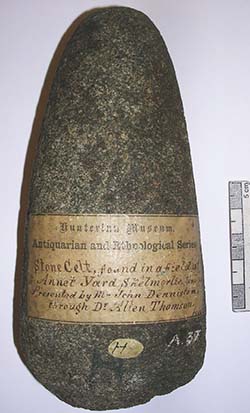Cutting Edge Chronicles
A blog on the biographical life-cycles of Neolithic polished stone axes in Scotland:
 The Hunterian's collection of Neolithic polished stone axes is of national significance, the polished stone axe being the characteristic artefact of this period (from c. 4000-2500 cal BC). The axe is not simply a utilitarian object of forest clearance but an artefact of great visual and tactile beauty requiring many hours of manufacture. Polished stone axes often obtain long Neolithic 'biographies' relating to their source, production, exchange, and previous ownership histories (the biographies of axes and people being hard to disentangle). This life-cycle affects the way in which an artefact would have been related to and understood in prehistory. Recent biographical approaches in stone axe studies have suggested that axe 'life-cycles' or 'biographies' and their meaning can also be built upon beyond prehistory as information exceeding their final deposition can be accrued up until the present day. In other words, artefact discovery, how it changed hands between collectors and museum collections, and ultimately its journey and arrival to the Hunterian Museum collections are a continuation of the life story of the axe, drawing new people into the narrative.
The Hunterian's collection of Neolithic polished stone axes is of national significance, the polished stone axe being the characteristic artefact of this period (from c. 4000-2500 cal BC). The axe is not simply a utilitarian object of forest clearance but an artefact of great visual and tactile beauty requiring many hours of manufacture. Polished stone axes often obtain long Neolithic 'biographies' relating to their source, production, exchange, and previous ownership histories (the biographies of axes and people being hard to disentangle). This life-cycle affects the way in which an artefact would have been related to and understood in prehistory. Recent biographical approaches in stone axe studies have suggested that axe 'life-cycles' or 'biographies' and their meaning can also be built upon beyond prehistory as information exceeding their final deposition can be accrued up until the present day. In other words, artefact discovery, how it changed hands between collectors and museum collections, and ultimately its journey and arrival to the Hunterian Museum collections are a continuation of the life story of the axe, drawing new people into the narrative.
The blog, 'Cutting edge Chronicles'builds on my existing PhD research into invisible narratives in Early Neolithic Scotland. It will focus on several individual axe 'biographies', providing information relating to each artefact's prehistoric life-cycle (raw material source, manufacture, exchange and ownership, final deposition) and its subsequent contemporary journey to the Hunterian Museum Collections. This process is inextricably linked to human agency, the actors with whom the artefacts interacted. In the biography of axes, actors include the axe makers, users but also antiquarian collectors and archaeologists as each axe journeyed to the Hunterian Museum from source to repository. The blogging process will therefore parallel the process of the axe making cycle; 'quarrying' in the museum stores, producing an axe, creating an axe narrative, and ultimately 'polishing' a range of information and data to create a story for public dissemination.
Denise Telford, PhD candidate in Archaeology
PhD Research: ‘Mainland Scotland in the Early Neolithic: Rewriting unspoken narratives and invisible characters into early prehistory'. This research provides a humane narrative for the exploration of late Mesolithic and Early Neolithic cosmologies through unorthodox approaches to personshood, gender, and childhood.

